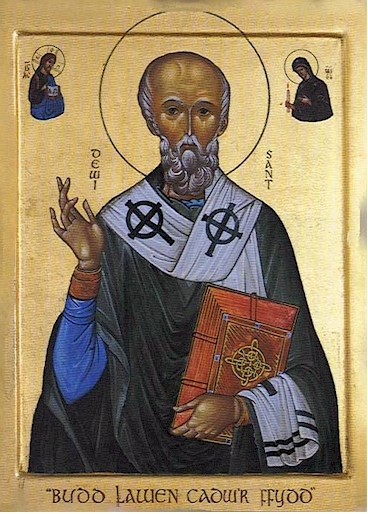Bishop of Menevia (†601)

| Orthodox Outlet for Dogmatic Enquiries | Biographies |
|---|
|
The Holy Hierarch David of Wales,
Bishop of Menevia (†601)
|
 |
A first approach to the indigenous Orthodox Saints and Martyrs of the Ancient Church who lived and who propagated the Faith in the British Isles and Ireland during the first millennium of Christianity and prior to the Great Schism is being attempted in our website in our desire to inform our readers, who may not be aware of the history, the labours or the martyrdom of this host of Orthodox Saints of the original One, Holy, Catholic and Apostolic Church of our Lord.
"The Church in The British Isles will only begin to grow when she begins to venerate her own Saints" (Saint Arsenios of Paros †1877)
|
SAINT DAVID was born in the sixth century in Wales. As a young man he became a monk and studied for many years as a priest. According to one tradition he was consecrated Bishop by the Patriarch of Jerusalem, when David went on pilgrimage there. He worked extensively to spread Christianity in Wales, especially in south-west Wales in what is now Pembrokeshire. Here he founded a monastery at Mynyw (Menevia), now St David's, and he is honoured as the first Bishop of St David’s. David and his monks followed a very austere rule, drinking only water and eating only bread and vegetables. Emulating the customs of the monks of the Egyptian desert with a regime of manual labour and study, his monastery became a nursery of saints. Personally, David was a most merciful man and practised frequent prostrations. As a favourite ascetic act he would often immerse himself in cold water while repeating the Psalms by heart. We know that he attended the Church Council of Brevi in c. 545 and here by common consent it is said that he was made Archbishop and his monastery proclaimed the Mother-Church of all Wales. He is said to have founded twelve monasteries, one of which may have been at Glastonbury in Somerset, the place where the Apostle Aristobulus of the Seventy and Righteous Joseph of Arimathea had, by tradition, first preached the Gospel in Britain and built the first church centuries before. St David worked many miracles even during his lifetime. After his repose in about 600, he came to be venerated widely in south Wales, but he was also revered in Ireland, Cornwall and Brittany. Indeed some believe that he actually travelled to Cornwall and Brittany and founded monasteries there too. St David's relics survive to this day and are enshrined in his cathedral at St David’s. St David is associated with the daffodil, the national flower of Wales, which is said to have grown around the site of his monastery. The leek, another national symbol of Wales, is said to have grown wild in the same place and to have formed the basis of the diet of St David and his monks. St David's feast, the Welsh national day, falls on 1 March.
Click on image below to watch the video with the Saint's Biography (source: https://youtu.be/zH8a6BcFATI)
|
Article published in English on: 7-8-2009.
Last update: 20-8-2020.